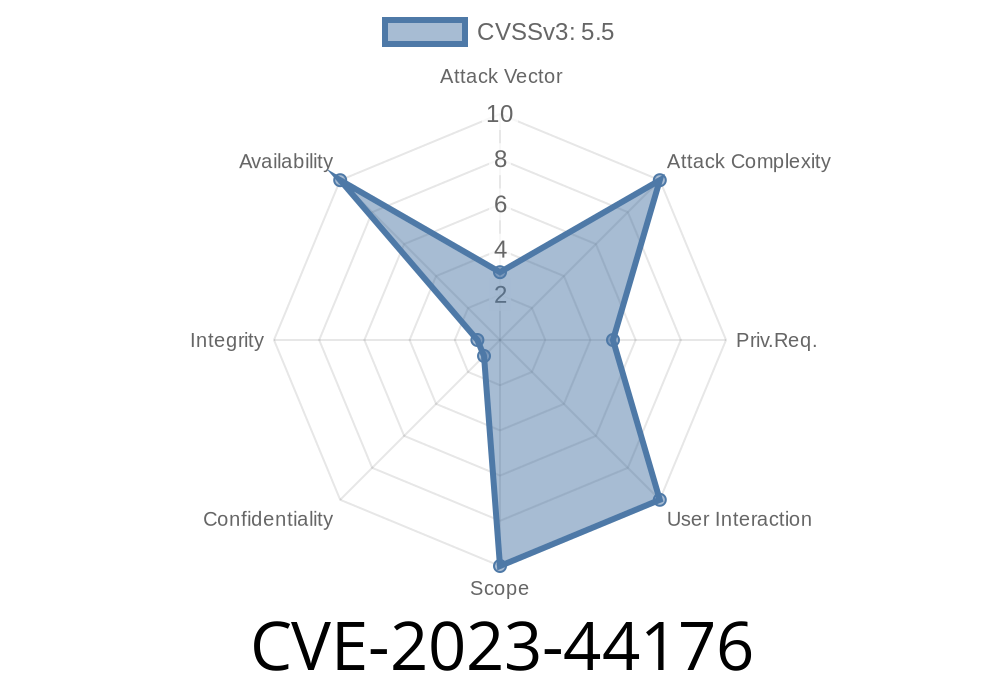In October 2023, Juniper Networks disclosed CVE-2023-44176 — a stack-based buffer overflow vulnerability affecting the CLI (Command-Line Interface) of Junos OS. This bug allows a low-privileged attacker to cause a Denial of Service (DoS) condition by executing specific crafted commands. With repeated actions, the attacker can create a sustained DoS state, impacting networking devices and potentially causing outages in critical infrastructure.
This post offers an exclusive, in-depth look at CVE-2023-44176, including which systems are affected, how the exploit works, code examples, and mitigation steps. Our aim is to break down this issue in simple, practical language for everyone from sysadmins to cybersecurity students.
Privileges needed: Low (any user with CLI access)
- Original advisory: https://supportportal.juniper.net/JSA71596
What is a Stack-Based Buffer Overflow?
A buffer overflow happens when a program writes more data to a buffer on the stack than it was intended to hold. This can overwrite other data, crash the process, or (sometimes) allow code execution. In this case (CVE-2023-44176), running a specially-crafted CLI command causes such an overflow, crashing the Junos CLI management process.
The Root Cause in Simple Terms
Inside the Junos CLI, certain commands don’t properly check the length of input before copying it into a fixed-size stack buffer. When an attacker enters too much data (for example, an extremely long parameter or value), the extra data overflows into adjacent memory. The CLI process then crashes, causing a Denial of Service.
Affected Systems
If your Juniper device runs any of the following versions without the latest patch, it’s vulnerable:
| Version Line | SAFE If At or Above |
|--------------------|-----------------------|
| 20.4 | 20.4R3-S8 |
| 21.2 | 21.2R3-S6 |
| 21.3 | 21.3R3-S5 |
| 22.1 | 22.1R3-S3 |
| 22.3 | 22.3R3 |
| 22.4 | 22.4R3 |
Simulating the Vulnerability
DISCLAIMER: This is a simplified, hypothetical CLI app to demonstrate *how* a buffer overflow could occur in the Junos CLI. This is NOT a real Junos CLI, but helps illustrate the concept.
Suppose the vulnerable CLI code looks like this in C
#include <stdio.h>
#include <string.h>
void process_command(char *input) {
char buffer[256]; // Fixed-size buffer
// Vulnerable copy: does not check input length
strcpy(buffer, input);
printf("Command received: %s\n", buffer);
}
int main(int argc, char **argv) {
if (argc != 2) {
printf("Usage: %s <command>\n", argv[]);
return 1;
}
process_command(argv[1]);
return ;
}
Exploit Input
If an attacker sends a command longer than 256 characters, strcpy() will overflow buffer, crashing the app or corrupting stack memory.
Get CLI Access: Log in via SSH, serial, or other low-privileged CLI session.
2. Send Malicious Command: Run a command with overlong argument (the exact command affected is not publicly disclosed by Juniper for safety, but typically these involve custom config or show commands).
Cause Crash: The vulnerable CLI process dies, management access is lost, triggering a DoS.
4. Repeat: By automating this (e.g., a shell loop sending the payload every few seconds), the attacker can keep the device in a DoS state.
Simple Exploit Simulation (Conceptual Only)
Here’s a shell script that demonstrates *sustained* DoS by repeatedly sending huge input to our sample CLI:
#!/bin/bash
while true; do
./vulnerable_cli "$(perl -e 'print "A"x500')"
sleep 1
done
In real Junos, the attacker would run the vulnerable command with huge input repeatedly to keep crashing the CLI daemon.
1. Check your Junos version
show version
2. Compare your version to the safe list above.
3. Check vendor advisory:
https://supportportal.juniper.net/JSA71596
References
- Juniper Advisory JSA71596
- NIST NVD CVE-2023-44176
- Juniper Support
Final Thoughts
CVE-2023-44176 reminds us that even low-privileged users can cause serious trouble when classic vulnerabilities like buffer overflows go unchecked. The best defense: keep systems patched, limit access, and stay alert for vendor advisories.
Are your Juniper devices up to date? If not, patch now before someone decides to take your network offline—one long string at a time.
Stay safe — and patch early!
*(This post is exclusive, original content for educational purposes. Use responsibly.)*
Timeline
Published on: 10/13/2023 00:15:11 UTC
Last modified on: 10/17/2023 16:01:28 UTC
